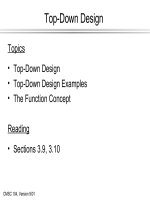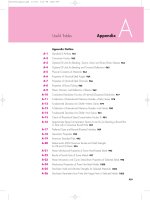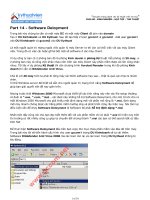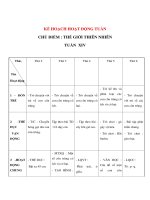Magento 14 themes design pptx
Bạn đang xem bản rút gọn của tài liệu. Xem và tải ngay bản đầy đủ của tài liệu tại đây (10.18 MB, 292 trang )
www.it-ebooks.info
Magento 1.4 Themes Design
Customize the appearance of your Magento 1.4
e-commerce store with Magento's powerful theming
engine
Richard Carter
BIRMINGHAM - MUMBAI
www.it-ebooks.info
Magento 1.4 Themes Design
Copyright © 2011 Packt Publishing
All rights reserved. No part of this book may be reproduced, stored in a retrieval
system, or transmitted in any form or by any means, without the prior written
permission of the publisher, except in the case of brief quotations embedded in
critical articles or reviews.
Every effort has been made in the preparation of this book to ensure the accuracy
of the information presented. However, the information contained in this book
is sold without warranty, either express or implied. Neither the author nor Packt
Publishing, and its dealers and distributors will be held liable for any damages
caused or alleged to be caused directly or indirectly by this book.
Packt Publishing has endeavored to provide trademark information about all of the
companies and products mentioned in this book by the appropriate use of capitals.
However, Packt Publishing cannot guarantee the accuracy of this information.
First published: January 2011
Production Reference: 1070111
Published by Packt Publishing Ltd.
32 Lincoln Road
Olton
Birmingham, B27 6PA, UK.
ISBN 978-1-849514-80-4
www.packtpub.com
Cover Image by Filippo Sarti ()
www.it-ebooks.info
Credits
Author
Richard Carter
Reviewer
Deepak Vohra
Acquisition Editor
David Barnes
Development Editors
Tariq Rakhange
Dhiraj Chandiramani
Technical Editor
Sakina Kaydawala
Indexer
Hemangini Bari
Editorial Team Leader
Mithun Sehgal
Project Team Leader
Ashwin Shetty
Project Coordinator
Poorvi Nair
Proofreader
Linda Morris
Graphics
Nilesh Mohite
Production Coordinator
Adline Swetha Jesuthas
Cover Work
Adline Swetha Jesuthas
www.it-ebooks.info
About the Author
Richard Carter is a frontend web developer with a passion for integrating designs
in a range of open source e-commerce and content management systems, including
Magento, MediaWiki, Joomla!, and Drupal. His expertise has led clients including
University College Dublin, Directgov, NHS Choices, and BusinessLink (http://
www.businesslink.gov.uk
), to consult his knowledge on open source systems.
Richard is Creative Director at Peacock Carter Ltd (
),
a web design and development agency based in the North East of England. He
graduated from the University of Durham in Software Engineering, and currently
lives in Newcastle-upon-Tyne. He blogs at lgreyandbattenburg.
co.uk/
and tweets at />Magento 1.4 Theme Design is the author's fourth book: Richard has previously written
MediaWiki Skins Design, Magento 1.3 Theme Design, and Joomla! 1.5 Templates Cookbook,
and has acted as a technical reviewer on MediaWiki 1.1 Beginners Guide and Inkscape
Illustrator's Guide.
Thanks to Magento for creating such a versatile e-commerce
system—this book wouldn't exist without it—and for those who took
the time to review Magento 1.3 Theme Design, as your comments were
valuable in updating the content for this book.
Thanks are also due to my family and friends, whose constant
support has proved both useful and welcome. In particular, my
thanks are due to EJ and, of course, Alexandra, who have put up
with months of inane mumbling and cursing at the screen!
www.it-ebooks.info
About the Reviewer
Deepak Vohra is a consultant and a principal member of the
software company. Deepak is a Sun Certied Java Programmer and Web Component
Developer, and has worked in the elds of XML and Java programming, and J2EE for
over ve years. Deepak is the co-author of the Apress book–Pro XML Development with
Java Technology and was the technical reviewer for the O'Reilly book–WebLogic: The
Denitive Guide. Deepak was also the technical reviewer for the Course Technology
PTR book–Ruby Programming for the Absolute Beginner, and the technical editor for
the Manning Publications book–Prototype and Scriptaculous in Action. Deepak is also
the author of the Packt Publishing books–JDBC 4.0 and Oracle JDeveloper for J2EE
Development and Processing XML Documents with Oracle JDeveloper 11g.
www.it-ebooks.info
www.PacktPub.com
Support les, e-books, discount offers,
and more
You might want to visit www.PacktPub.com for support les and downloads related
to your book.
Did you know that Packt offers e-book versions of every book published, with PDF
and e-Pub les available? You can upgrade to the e-book version at
www.PacktPub.
com
and as a print book customer, you are entitled to a discount on the e-book copy.
Get in touch with us at for more details.
At
www.PacktPub.com, you can also read a collection of free technical articles, sign
up for a range of free newsletters and receive exclusive discounts and offers on Packt
books and e-books.
Do you need instant solutions to your IT questions? PacktLib is Packt's online digital
book library. Here, you can access, read, and search across Packt's entire library of books.
Why Subscribe?
• Fully searchable across every book published by Packt
• Copy and paste, print and bookmark content
• On demand and accessible via web browser
Free Access for Packt account holders
If you have an account with Packt at www.PacktPub.com, you can use this to access
PacktLib today and view nine entirely free books. Simply use your login credentials
for immediate access.
www.it-ebooks.info
Table of Contents
Preface 1
Chapter 1: Introduction to Magento 7
What is Magento? 8
Magento's features 9
Differences between Magento 1.3 and Magento 1.4 themes 9
Default Magento 1.4 themes 10
Magento Default theme 10
Modern theme 17
Blue theme 20
Showcase of Magento themes 20
Harvey Nichols 21
Mark One 23
Zhu Zhu 24
Challenges of Magento theme design 27
Why create a custom Magento theme? 27
Installing Magento 1.4 27
Pre-installation check: magento-check.php 28
Downloading Magento 1.4 Community Edition 30
Installing and conguring Magento 30
Conguring le permissions 32
Conguring Magento 33
Creating your Magento administration account 36
Summary 37
Chapter 2: Exploring Magento Themes 39
Magento terminology 39
Magento websites and Magento stores 40
Magento interfaces 41
Magento packages 42
www.it-ebooks.info
Table of Contents
[ ii ]
Magento themes 43
Base theme 44
Default themes 44
Non-default themes 45
Blocks in Magento 46
Content blocks 46
Structural blocks 47
What makes a Magento theme? 47
Unique aspects of a Magento theme 47
Typical Magento theme le types 48
Skins 48
Layouts 48
Templates 49
Locales 49
Theme hierarchy in Magento: the fallback pattern 49
The base theme 49
An example of theme hierarchy 50
The Blank theme 52
Installing and activating a Magento theme 53
Installing a Magento theme 54
Activating a Magento theme 56
Good practice in Magento theming 60
Summary 61
Chapter 3: Magento Theme Basics 63
Magento's cache 63
Disabling Magento's cache 64
Changing your store's logo 67
Changing your store's logo using a static block in Magento 71
Changing your store's favicon 71
What is a favicon? 71
Favicon inspiration 72
Changing the favicon 74
Displaying products on the homepage 76
Adding the featured category 77
Adding a product in Magento 80
Finding your category's ID 85
Adding the featured category to the homepage 86
Customizing the default placeholder product image 90
Customizing the product image watermark 92
Summary 97
www.it-ebooks.info
Table of Contents
[ iii ]
Chapter 4: Magento Theme Layouts 99
Magento layout terminology 99
Default layout 100
Layout updates 100
Template Path Hints and Block Name Hints 100
Enabling Template Path Hints 100
Enabling Block Name Hints 104
Restricting who can see the hints 107
A brief guide to XML 108
Self-closing elements in XML 109
Closing XML elements normally 109
Entity escapes in XML 109
Changing a page's layout 110
Changing a page's layout through Magento's administration panel 110
Customizing a Magento page through Layout Update XML eld 114
Customizing a Magento page through layout les 116
Default and non-default handles in Magento layout 118
What is a handle? 118
The default handle 119
Non-default handles 119
Useful handles in Magento 120
Summary 121
Chapter 5: Non-default Magento Themes 123
Beginning a new Magento 1.4 theme 123
The case study design 124
Creating new theme directories 124
Basic local.xml layout le 125
Enabling the new theme 126
Styling your store's header 128
Styling the user account links 130
Customizing the welcome message 131
Styling the search box 132
Customizing a Magento template le 134
Styling your store's content area 136
Styling the column blocks 138
Customizing the sidebar basket/cart block 139
Customizing the sidebar COMPARE PRODUCTS block 140
Customizing the sidebar poll block 142
Styling the sidebar blocks 143
www.it-ebooks.info
Table of Contents
[ iv ]
Styling your store's footer 146
Changing the footer links 147
The theme so far 150
Summary 150
Chapter 6: More Magento Theming 153
The theme so far 153
Using @font-face with Magento 1.4 154
Converting typefaces for @font-face 155
@font-face support across browsers 155
EOT: Internet Explorer 155
TTF: Safari, Opera, Chrome, and Firefox 155
OTF: Safari, Opera, Chrome, and Firefox 155
SVG: iPhone and Chrome 155
WOFF: Firefox 156
CSS for @font-face 156
Adjusting font size 158
Better results for different weights of a typeface 158
Magento's customer account views 159
Styling the log in view 159
Styling the register an account view 166
Navigation in Magento 167
Magento's product view 170
Customizing the product view template 171
Disabling Magento reviews through the CMS 172
Customizing the product view layout 172
Summary 173
Chapter 7: Customizing Advanced Magento Layout 175
Magento error messages and views 175
Customizing Magento's 404—not found view 176
The no JavaScript error message 183
Styling the default message in Magento (.note-msg) 186
Styling your store's breadcrumb 188
Adding JavaScript into your Magento theme: Lightbox-style
effects to Magento's product page 192
Adding a JavaScript le using Magento layout 192
Editing the product template le to include Lightbox 194
Changing image paths in the JavaScript le 196
Lightbox extensions for Magento 1.4 197
Adding a conditional stylesheet for Internet Explorer in Magento 198
Creating a new stylesheet for a previous Internet Explorer version 199
Using Magento layout to specify a conditional stylesheet 199
www.it-ebooks.info
Table of Contents
[ v ]
Adding a new block to your Magento theme 200
Creating a static block in Magento's CMS 201
Customizing your Magento store's labels with translate.csv 206
Adding a custom block to Magento CMS pages 208
Summary 209
Chapter 8: Magento E-mail Templates 211
Transactional e-mail templates in Magento 211
Customizing Magento newsletter templates 218
Integrating external HTML newsletter systems with Magento 221
Making Magento e-mail templates
ready for use 228
Testing e-mail templates 230
Summary 230
Chapter 9: Social Media and Magento 231
Twitter integration with Magento 232
Adding a 'Follow Us On Twitter' button to your Magento store 232
Generating the markup from the Twitter website 232
Adding a static block in Magento for your Twitter button 234
Updating your theme's layout le for the
'Follow Us' button 235
Embedding a 'latest tweets' widget into your Magento store 236
Integrating Twitter through Magento extensions 241
Integrating Facebook with Magento 242
Adding a 'Like' button to your Magento
store's product pages 243
Getting the 'Like' button markup 244
Integrating the Facebook 'Like box' widget in your Magento store 247
Integrating Facebook with Magento extensions 251
Further social media integration with Magento 252
Social bookmarking in Magento 252
ShareThisProduct extension for Twitter, Facebook, and MySpace 252
Magento Social Bookmarking Services extension 252
Logging in with a social networking account 252
Summary 253
Chapter 10: Magento Print Style 255
Magento Default theme's print styling 255
Using Magento layout to include a print stylesheet 260
Creating a custom print stylesheet for your Magento theme 261
Print style for content blocks in Magento 261
Print style for typography in Magento 265
www.it-ebooks.info
Table of Contents
[ vi ]
Print style for links in Magento 267
Styling links 267
Displaying a printed link's destination 268
Overcoming a common browser-specic problem in print stylesheets 269
Summary 269
Index 271
www.it-ebooks.info
Preface
Magento is a popular open source e-commerce project. While it comes with a number
of 'default' themes to change the look and feel of your store, many people both
new and old to Magento struggle with even the more basic aspects of customizing
Magento themes. When you read this book you'll see how to change the basics of
your Magento theme, create a new custom theme, and much more.
The book is a step-by-step guide to theming Magento, aimed at readers with little
technical expertise.
In short, the book guides the common aspects of theming and customizing Magento
1.4 and an equally useful step-by-step walkthrough of integrating more unusual
items into your Magento store.
What this book covers
Chapter 1, Introduction to Magento, introduces Magento, including the installation
of the software and avoiding common pitfalls in this process. This chapter is an
invaluable guide for those who are new to everything in Magento, or just those
who are new to Magento 1.4.
Chapter 2, Exploring Magento Themes, introduces theming in the context of Magento
and covers terminology used within the Magento project that relates to Magento
in a wider context—from interfaces to packages—and more specically, theme
terminology, from skins to layouts, and template les.
Chapter 3, Magento Theme Basics, covers the basics of Magento theming, from
changing your store's color scheme to updating your store's logo. This chapter
concentrates on altering existing Magento themes to achieve the theming aims for
your store.
www.it-ebooks.info
Preface
[ 2 ]
Chapter 4, Magento Theme Layouts, provides an overview of what a layout is in the
context of the Magento system, related terminology including layout handles and
layout actions, and uses a number of useful step-by-step guides to common tasks
you may need to use within Magento to create your theme.
Chapter 5, Non-default Magento Themes, covers the building blocks of creating your
own Magento 1.4 theme, from replicating the necessary le hierarchy for your theme
to enabling your new theme, styling your store's search feature, and altering your
store's footer area.
Chapter 6, More Magento Theming, built on the previous chapter's content, from
integrating
@font-face fonts into your Magento store for higher-delity
typography in your Magento store to customizing your store's navigation.
Chapter 7, Customizing Advanced Magento Layout, looks into more advanced
customization and manipulation of Magento layout in order to customize your
Magento store.
Chapter 8, Magento E-mail Templates, looks at customizing e-mail templates that
are used to contact customers during key processes of their interaction with
your Magento store, as well as integrating the well-known e-mail newsletter
system-CampaignMonitor.
Chapter 9, Social Media and Magento, guides you through integrating popular social
media websites—Twitter and Facebook—with your Magento store, from adding a
Facebook Like button to your store to adding your latest tweets to your Magento store.
Chapter 10, Magento Print Style, sees you creating a custom print stylesheet to better
allow your store's customers to print key pages from your store.
What you need for this book
You will need version 1.4 of Magento Community Edition or the equivalent version
of the Enterprise or Professional editions. A familiarity with CSS and (X)HTML is
recommended, and knowledge of PHP is benecial.
Who this book is for
This book is aimed at web designers and web developers who are not familiar with
Magento at all and to Magento designers and developers who are more familiar with
Magento 1.3 than Magento 1.4. The book assumes knowledge of HTML and CSS and
an awareness, but not in-depth knowledge of PHP syntax.
www.it-ebooks.info
Preface
[ 3 ]
Conventions
In this book, you will nd a number of styles of text that distinguish between
different kinds of information. Here are some examples of these styles, and an
explanation of their meaning.
Code words in text are shown as follows: " The default layout for the checkout view
is dened in the
checkout.xml le in the app/design/frontend/base/default/
layout
directory."
A block of code is set as follows:
<action method="setTemplate">
<template>page/2columns-left.phtml</template>
</action>
When we wish to draw your attention to a particular part of a code block, the
relevant lines or items are set in bold:
<reference name="left">
<block type="core/template" name="left.permanent.callout"
template="callouts/left_col.phtml" />
</reference>
New terms and important words are shown in bold. Words that you see on the
screen, in menus or dialog boxes for example, appear in the text like this: " Uncheck
the checkbox next to Add Block Names to Hints and select Yes from the drop-down
eld ".
Warnings or important notes appear in a box like this.
Tips and tricks appear like this.
Reader feedback
Feedback from our readers is always welcome. Let us know what you think about
this book—what you liked or may have disliked. Reader feedback is important for
us to develop titles that you really get the most out of.
www.it-ebooks.info
Preface
[ 4 ]
To send us general feedback, simply send an e-mail to ,
and mention the book title via the subject of your message.
If there is a book that you need and would like to see us publish, please send
us a note in the SUGGEST A TITLE form on
www.packtpub.com or e-mail
If there is a topic that you have expertise in and you are interested in either writing
or contributing to a book, see our author guide on
www.packtpub.com/authors.
Customer support
Now that you are the proud owner of a Packt book, we have a number of things to
help you to get the most from your purchase.
Downloading the example code for this book
You can download the example code les for all Packt books you have
purchased from your account at . If you
purchased this book elsewhere, you can visit ktPub.
com/support and register to have the les e-mailed directly to you.
Errata
Although we have taken every care to ensure the accuracy of our content, mistakes
do happen. If you nd a mistake in one of our books—maybe a mistake in the text or
the code—we would be grateful if you would report this to us. By doing so, you can
save other readers from frustration and help us improve subsequent versions of this
book. If you nd any errata, please report them by visiting ktpub.
com/support
, selecting your book, clicking on the errata submission form link, and
entering the details of your errata. Once your errata are veried, your submission
will be accepted and the errata will be uploaded on our website, or added to any list
of existing errata, under the Errata section of that title. Any existing errata can be
viewed by selecting your title from />www.it-ebooks.info
Preface
[ 5 ]
Piracy
Piracy of copyright material on the Internet is an ongoing problem across all media.
At Packt, we take the protection of our copyright and licenses very seriously. If you
come across any illegal copies of our works, in any form, on the Internet, please
provide us with the location address or website name immediately so that we can
pursue a remedy.
Please contact us at
with a link to the suspected
pirated material.
We appreciate your help in protecting our authors, and our ability to bring you
valuable content.
Questions
You can contact us at if you are having a problem with
any aspect of the book, and we will do our best to address it.
www.it-ebooks.info
www.it-ebooks.info
Introduction to Magento
The Internet is an important sector of many businesses, both large and small, in the
modern world; it's now rare for a company to not have at least a basic web presence
and increasingly unlikely that a company's products are not sold online. Magento
is a powerful e-commerce system, used by international organizations such as
Homedics, The North Face, Samsung, and 3M.
In this chapter, you will see the following:
• Take a look at what Magento is and what Magento can do
• Discover the differences between Magento 1.3 and Magento 1.4
• See the default themes that come installed with Magento 1.4
• Look at a showcase of custom Magento themes from real websites
• Find out the particular challenges in customizing Magento themes
• Install and congure Magento 1.4 ready for theming
As you will come to see, Magento is quite a large e-commerce system and this book
will guide you through customizing its quirks and eccentricities.
www.it-ebooks.info
Introduction to Magento
[ 8 ]
What is Magento?
Magento Commerce () is an open source
e-commerce framework: simply, it's a free to use and modify way to start selling
products online.
Magento is written in the PHP programming language using an object-orientated
architecture, allowing features such as additional payment gateways, integration
with social networks such as Twitter and Facebook, and customization for different
product types to be easily added.
The default installation of Magento provides a huge number of e-commerce and
related features, supports multiple stores being managed from the same control
panel, and—importantly for us—provides the ability for very heavily customized
themes. The system has been criticized for being slow to load, which can be at least
partially mitigated with the use of built-in caches.
www.it-ebooks.info
Chapter 1
[ 9 ]
Magento's features
As with other e-commerce systems, Magento allows products to be added, edited,
manipulated, and organized within categories. You are able to control your products'
names, descriptions, prices, and upload multiple photographs for each product in
your store. Magento also lets you create variations of products in your store, so you
can have one product which is available in multiple colors (such as blue, red, and
black) within Magento. In other e-commerce systems, you may have to add the blue,
red, and black products as three separate products.
In addition to these 'standard' e-commerce features, Magento also has provisions to
perform the following:
• Manage both the sending of e-mail newsletters and the managing of
subscribers to these lists
• Manage non-product pages through its content management system (CMS)
• Organize polls of your store's visitors
Additional features are available in the other versions of Magento; Magento
Enterprise Edition and Magento Professional Edition, but this book concentrates
on Magento Community Edition and everything in this book can be applied to all
editions of Magento.
Differences between Magento 1.3 and
Magento 1.4 themes
There are some fairly major changes between Magento 1.3 and Magento 1.4. Magento
1.4 xes some known bugs and adds new features, some of which had to be added as
separate modules in Magento 1.3, including the use of canonical URLs.
It is not only the features of Magento that vary between versions 1.3 and 1.4,
although the structure of themes has changed quite signicantly. In particular,
the way theme hierarchy works in Magento 1.4 has been changed to allow greater
modularity between themes. That is, the new theme hierarchy in Magento means
that there should always be some styling to elements in your theme if you forget to
style them.
In addition to this, default classes and ids used in Magento 1.3 have been changed
in Magento 1.4 and the
.phtml templates, that a Magento theme is comprised of,
have been changed to provide improved accessibility in places, or just to better
accommodate new or changed functionality. In particular, alt and title attributes
have been added to the markup and HTML has been validated throughout the
template blocks.
www.it-ebooks.info
Introduction to Magento
[ 10 ]
As such, porting a Magento 1.3 theme to Magento 1.4 is likely to be a very tedious
task, and you may well be better off starting the theme from scratch.
Default Magento 1.4 themes
By default, Magento comes with three different themes:
• Default
• Modern
• Blue
You can easily preview these themes on the Magento demonstration site at
, and by selecting an option from the
Select Store drop-down box located in the footer of the site (Main Store displays
Magento's default theme):
Magento Default theme
The Default theme is what you see when you install Magento 1.4. The homepage is
based upon a three column structure:
www.it-ebooks.info
Chapter 1
[ 11 ]
In the preceding screenshot, you can see the distinction between each column with
the central column being used for content and the side columns being used for
additional information such as the shopping cart, product tags, and advertisements
for products within your store.
www.it-ebooks.info
Introduction to Magento
[ 12 ]
Product pages display a prominent picture of the product in a two column layout:
On the product page, you can see Magento adds a breadcrumb trail to where
the page is located within your store's hierarchy, as well as including multiple
photographs of the product which can be enlarged.
Finally, each product category page reverts to the three column structure of
the homepage:
www.it-ebooks.info









